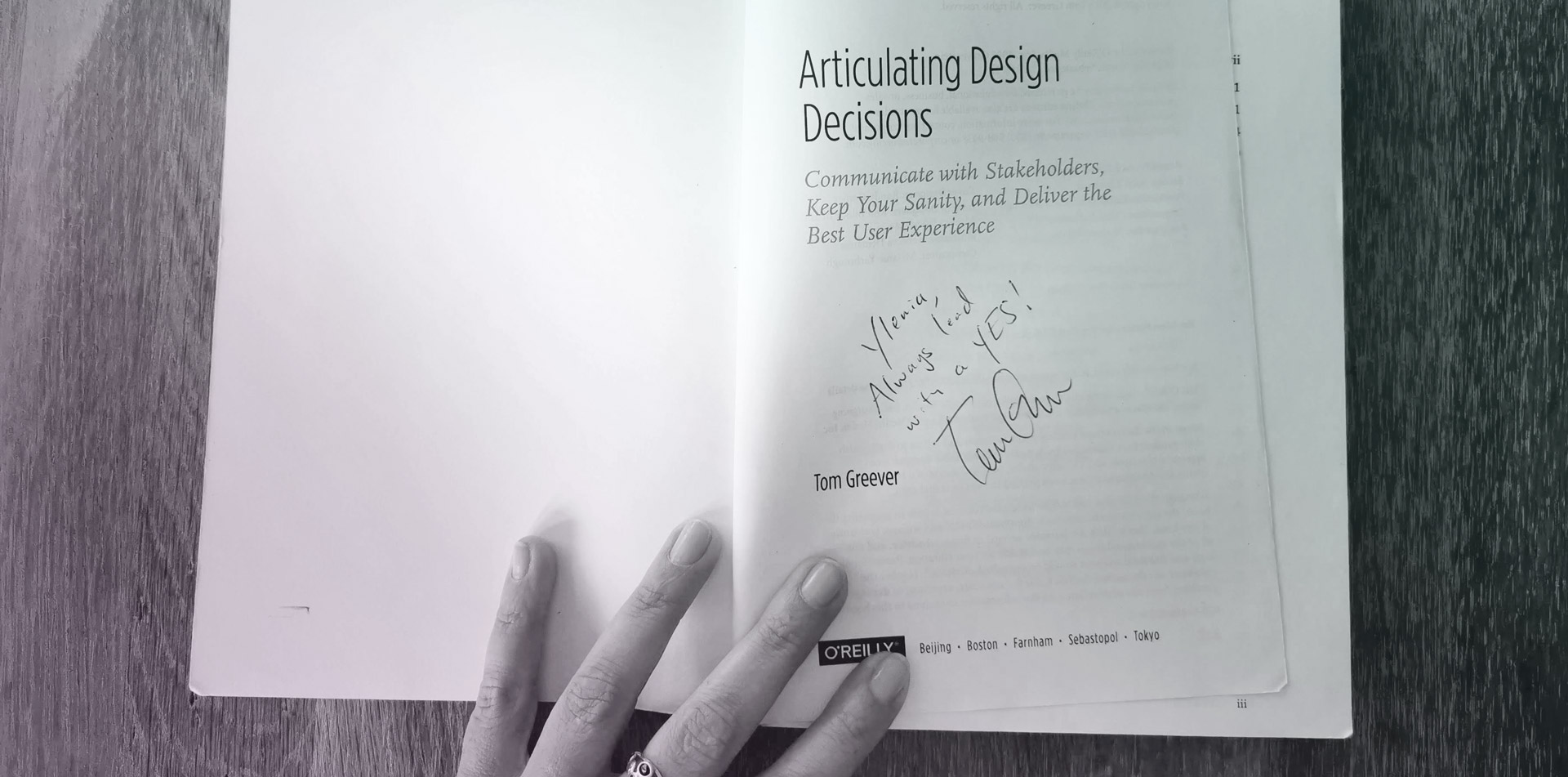Leading with a “yes” in real life
introduction
I came to know Tom Greever at Intersection Conference in 2019. I must admit, I was attracted by the fun title of his speech: “HAIRY ARMS, PAINTING DUCKS, AND DESIGN DECISIONS”.
DATE
- August 26th, 2021

In this speech, Tom drove us through the main topics of his book, focused on techniques to handle speaking to both designers and non-designers, without getting a migraine.
His arguments were so convincing I had to buy his book and of course ask for a personalized sign!
The signature goes: “Ylenia, always lead with a YES!”. I wasn’t sure what that meant and was imagining something like a “yes day” which can lead to some very dangerous places, especially with clients.
“Make the logo bigger”
“Yes”
“Let’s make it blue on yellow”
“Yes”
You can see where I’m going with this.
But the explanation is much more relaxing than I first though. When you start answering with a yes, your positive reaction sets the basis for a collaborative environment, in which every idea is welcome and creativity is boosted.
Imagine being in a meeting with a client who’s proposing challenges mostly unreachable for budget or time schedule.
You don’t shut down the conversation with something like “we can’t do that because is out of scope”, “this is far from the concept, we can’t add this feature”. Instead you can say “yes, we’ll keep this feature under consideration and see how to fit it into the concept”. You always stay positive and collaborative.
The concept of “leading with a yes” was developed by Dave Ferguson, one of the cofounders of NewThing Network, in collaboration with Tom Greever. Apart from the applications on my work life, I’ve found it mind-blowing applied to my personal life. Every time the conversation requires to converge to a solution (planning parties, vacations, dinners,..) I’ve started leading with a yes!
It’s not simple at the beginning because we were told to express our feelings and ideas, so the first reaction is usually not a yes. After practicing a while, being present to myself during any conversation and evaluating every sentence, I was able to understand the power of this concept.
Everyone likes to be approved, empowered, listened and Tom explains how to benefit from this. He also walk us through how to organize and lead a meeting with stakeholders, with some really practical information.
I really felt understood by reading this book. He knows the struggle of being a designer in this highly competitive field because “great design is the expected norm”, no matter what the prerogatives are, like no budget, no time, complex briefs. Yes, it is still a new world for many of our clients, and making decisions based on intuition is not helping the cause.
It is our duty as communicators to explain other designer and non-designers what’s going on in our minds. We need to evangelize design principles and make them easy to understand.
I usually don’t like explaining my job to non-designers. Recently i had to do it 5 times in a 2-day round, all of them to really analogical people. It always starts with a big nervous laugh and continues with a “in a more practical way?”.
Every. Single. Time.
I mean, it’s not their fault if “user experience design” isn’t something easy to understand! We don’t understand it either!
People spend hours fighting each other on whether a designer should code or not! It’s just not fair. I can’t even start from “design means…” because i would lose them a minute after. So what i just usually do is telling them to think about a website or an app that really frustrated them and then I explain that, well, no one has done my job there! Other great example i usually use is Norman’s doors. That always works for real life use of my job.
Back to the book, there are some great processes to lead a meeting with clients or stakeholders and I’m planning to use them as soon as I get the chance because, of course I can’t impose this process over the one that’s been used for years in my agency. I also am a team of one for the user experience sector so I don’t have peers to chat with, to ask for feedbacks and team up.
Many things I’ve learnt and I’m truly happy to have spent time to read this book.
If you want to comment this article, please feel free to do it on my Medium page